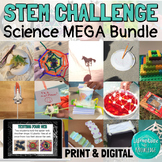STEM Challenge Design a Shadow Puppet with Light Energy Lab PRINT and DIGITAL
- PDF
What educators are saying
Also included in
- This light energy unit bundle includes 7 one hour lesson plans with all of the resources needed to implement them in your science classroom. This unit covers concepts like electromagnetic waves, speed of light, wavelengths and color, reflection, refraction, absorption, as well as the difference betwPrice $17.50Original Price $25.00Save $7.50
- This collection of easy to implement STEM challenges and hands on science lab experiments covers topics like: the moonsolar power light energysound energyanimal adaptations earthquakesvolcanoespaleontologygeometrysurface tensionEach resource in the bundle includes: background informationstudent direPrice $35.13Original Price $70.25Save $35.12
Description
For this STEM Challenge, students must design and test a paper shadow puppet using a simple light stage. This activity is a great way to incorporate art and design with light energy concepts in your science classroom.
This resource includes:
- teacher directions with suggestions, discussion questions, and extension ideas
- 3 slides of background information about shadow puppets and their origins in ancient Chinese culture
- 4 slides setting up the challenge with student directions and photographs
- a student response worksheet
- a scoring rubric
- a force copy link to a digital Google Slides version
Your students will love this simple but challenging STEM activity that combines multicultural education, science, and engineering. You will love that it requires minimal prep time and very few materials!
Get my growing STEM bundle instead and save 50%! The best news is you'll get all future STEM resources that I add for free!
Please follow my store here for more great resources!
You can also find me on Facebook, Instagram, and lafountaineofknowledge.com where you'll discover ideas, inspiration, and plenty of freebies! Or join my email list to get a monthly newsletter with exclusive FREE resources you can't get anywhere else!
Want free money to spend on Teachers Pay Teachers? Rate this product to earn some TpT credit! Leaving feedback helps us both out and takes less than a minute! Your support makes it possible for me to continue making and sharing great resources! Thank you!
Credits: All photos used with permission. Photos on page 4 by Hiart on Wikimedia Commons, photo on page 5 by Jimmie on Wikimedia Commons, background sourced via Pixabay and used with permission. All other photos were taken by Shea LaFountaine of LaFountaine of Knowledge. The border on page 11 was created by Chirp Graphics and used with permission. Fonts used include: Amatic SC by Vernon Adams and Coming Soon by Open Window. Fonts used with permission under open source licenses.







